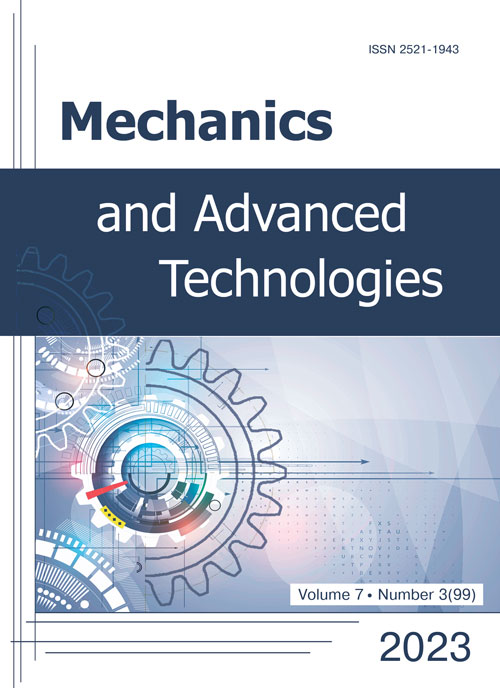Model of the control object of the mechatronic microclimate system of a medium-sized greenhouse
DOI:
https://doi.org/10.20535/2521-1943.2023.7.3.290773Keywords:
microclimate, simplified model, modeling, heat and mass transfer processes, greenhouse object, temperature field, flow rateAbstract
Sudden changes in air temperature and humidity have a negative impact on crop production. Modern methods of regulating the microclimate of greenhouse facilities are reduced to the simplest one - controlling the flow and temperature of air masses. The aim of this work is to create and test (verify the plausibility) a simplified model of the microclimate of a medium-sized greenhouse. The simplified greenhouse model takes into account the main processes that occur under the influence of external factors (air exchange, mass transfer, moisture transfer, heat transfer), and also takes into account the geometric and spatial characteristics of the object. Each test experiment involves determining the effect of only one parameter at fixed values of all other parameters. A simplified reference model of changes in microclimate parameters (temperature, air velocity and pressure) was developed using Ansys software. Using computer modelling of temperature fields and velocities, an analysis was carried out to determine the possibility of using the model in the control system. The microclimate characteristics were analysed when air pressure, velocity and temperature were stabilised. The results of the study and the developed model are suitable for use in control algorithms for the greenhouse mechatronic system to take into account cyclic daily changes in parameters.
References
- N. Radojević, D. Kostadinović, H. Vlajkovic and E. Veg, “Microclimate Control in Greenhouses”, FME Transactions, vol. 42, no. 2, pp. 167–171, 2014. DOI: https://doi.org/10.5937/fmet1402167R.
- G. Nicolosi, R. Volpe and A. Messineo, “An Innovative Adaptive Control System to Regulate Microclimatic Conditions in a Greenhouse”, Energies, vol. 10, no. 5, p. 722, 2017. DOI: https://doi.org/10.3390/en10050722.
- V. K. Singh and K. N. Tiwari, “Prediction of greenhouse micro-climate using artificial neural network applied ecology and environmental research”, Applied ecology and environmental research, vol. 15, no. 1, pp. 767–778, 2017. DOI: https://doi.org/10.15666/aeer/1501_767778.
- V. Diordiev, A. Kashkarov and O. Diordiev, “Automated monitoring and control system for microclimate of the greenhouse”, Scientific bulletin of the Tavria Agrotechnological State University, vol. 2, no. 8, 2018. DOI: https://doi.org/10.31388/2220-8674-2018-2-25.
- Zilong Fan, Yiming Li, Lingling Jiang, Lu Wang, Tianlai Li and Xingan Liu, “Analysis of the Effect of Exhaust Configuration and Shape Parameters of Ventilation Windows on Microclimate in Round Arch Solar Greenhouse”, Sustainability, vol. 15, no. 8, p. 6432, 2023. DOI: https://doi.org/10.3390/su15086432.
- L. G. Vikhrova, V. M. Kalich and T. O. Prokopenko, "Mathematical and computer modeling of temperature distribution in a greenhouse for the development of a control system", Collection of scientific works of the Kirovohrad National Technical University, no. 24 (2), pp. 174-180, 2011.
- M. Nachidi, Stabilization of T-S Fuzzy Systems with Application on a Greenhouse. Saarbrucken, Germany: Lap Lambert Academic Publishing GmbH KG, 2012, 160 p.
- D. H. Zhang, X. Q. Wu and C. Y. Zhang, “The application of fuzzy control in greenhouse environment control”, Appl. Mech. Mater, vol. 543–547, pp. 1432–1435, 2014. DOI: https://doi.org/10.4028/www.scientific.net/AMM.543-547.1432.
- F. He, C. Ma, J. Zhang and Y. Chen, "Greenhouse air temperature and humidity prediction based on improved BP neural network and genetic algorithm", in Advances in Neural Networks – ISNN 2007. Berlin, Heidelberg: Springer Berlin Heidelberg, 2007, pp. 973–980. DOI: https://doi.org/10.1007/978-3-540-72395-0_119.
- B. Yang, Y. Chen, Z. Guo, J. Wang, C. Zeng, D. Li, H. Shu, J. Shan, T. Fu and X. Zhang, “Levenberg-Marquardt backpropagation algorithm for parameter identification of solid oxide fuel cells”, Int. J. Energy Res., vol. 45, no. 12, pp. 17903–17923, 2021. DOI: https://doi.org/10.1002/er.6929.
- C. Lv, Y. Xing, J. Zhang, X. Na, Y. Li, T. Liu et al., “Levenberg–Marquardt Backpropagation Training of Multilayer Neural Networks for State Estimation of a Safety-Critical Cyber-Physical System”, IEEE Trans. Ind. Inform., vol. 14, no. 8, pp. 3436–3446, 2018. DOI: https://doi.org/10.1109/TII.2017.2777460.

Downloads
Published
How to Cite
Issue
Section
License
Copyright (c) 2023 Єлизавета Синицина, Олександр Губарев

This work is licensed under a Creative Commons Attribution 4.0 International License.
Authors who publish with this journal agree to the following terms:
- Authors retain copyright and grant the journal right of first publication with the work simultaneously licensed under CC BY 4.0 that allows others to share the work with an acknowledgement of the work's authorship and initial publication in this journal.
- Authors are able to enter into separate, additional contractual arrangements for the non-exclusive distribution of the journal's published version of the work (e.g., post it to an institutional repository or publish it in a book), with an acknowledgement of its initial publication in this journal.
- Authors are permitted and encouraged to post their work online (e.g., in institutional repositories or on their website) prior to and during the submission process, as it can lead to productive exchanges, as well as earlier and greater citation of published work











